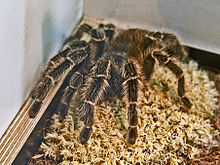Lasiodora
| Lasiodora | |
|---|---|

| |
| Lasiodora difficilis | |
| Scientific classification | |
| Domain: | Eukaryota |
| Kingdom: | Animalia |
| Phylum: | Arthropoda |
| Subphylum: | Chelicerata |
| Class: | Arachnida |
| Order: | Araneae |
| Infraorder: | Mygalomorphae |
| Family: | Theraphosidae |
| Genus: | Lasiodora C. L. Koch, 1850[1] |
| Type species | |
| L. klugi (C. L. Koch, 1841)
| |
| Species | |
|
7, see text | |
Lasiodora is a genus of tarantulas that was first described by Ludwig Carl Christian Koch in 1850.[2] They are often very large; body lengths of up to 25 centimetres (9.8 in), including the legs, are not unusual.
Diagnosis[edit]
This genus can be distinguished from other tarantulas by the presence of hairs used for stridulation on the upper area of the coxae of leg 1 and 2. Males also own a triangular keel below the apex of the palpal bulb, females also have a sclerotized (hardened by sclerotin) area between the two sections of the spermathecae.[3]
Species[edit]
As of December 2023[update] it contains seven species, found in Brazil:[1]
- Lasiodora benedeni Bertkau, 1880 – Brazil
- Lasiodora camurujipe Bertani, 2023 – Brazil
- Lasiodora franciscana Bertani, 2023 – Brazil
- Lasiodora klugi (C. L. Koch, 1841) (type) – Brazil
- Lasiodora parahybana Mello-Leitão, 1917 – Brazil
- Lasiodora sertaneja Bertani, 2023 – Brazil
- Lasiodora subcanens Mello-Leitão, 1921 – Brazil
Transferred to other genera[edit]
- Lasiodora auronitens (Keyserling, 1891) → Pycnothele auripila
- Lasiodora boliviana (Simon, 1892) → Acanthoscurria insubtilis
- Lasiodora brevibulbus (Valerio, 1980) → Crypsidromus brevibulbus
- Lasiodora breyeri (Becker, 1878) → Metriopelma breyeri
- Lasiodora carinata (Valerio, 1980) → Crypsidromus carinatus
- Lasiodora colorata (Valerio, 1982) → Hapalopus coloratus
- Lasiodora drymusetes (Valerio, 1982) → Davus fasciatus
- Lasiodora familiaris (Simon, 1889) → Cyclosternum familiare
- Lasiodora gutzkei (Reichling, 1997) → Acentropelma gutzkei
- Lasiodora icecu (Valerio, 1980) → Crypsidromus icecu
- Lasiodora isabellina (Ausserer, 1871) → Crypsidromus isabellinus
- Lasiodora lakoi Mello-Leitão, 1943 → Megaphobema lakoi
- Lasiodora panamana Petrunkevitch, 1925 → Neischnocolus panamanus
- Lasiodora parvior Chamberlin & Ivie, 1936 → Neischnocolus panamanus
- Lasiodora porteri Mello-Leitão, 1936 → Grammostola rosea
- Lasiodora tetricus (Simon, 1889) → Miaschistopus tetricus
- Lasiodora trinitatis (Pocock, 1903) → Spinosatibiapalpus trinitatis
- Lasiodora trinitatis pauciaculeis (Strand, 1916) → Spinosatibiapalpus trinitatis pauciaculeis
- Lasiodora velox (Pocock, 1903) → Cymbiapophysa velox
- Lasiodora weijenberghi Thorell, 1894 →Eupalaestrus weijenberghi
- Lasiodora zebrata (Banks, 1909) → Davus ruficeps
See also[edit]
References[edit]
- ^ a b Gloor, Daniel; Nentwig, Wolfgang; Blick, Theo; Kropf, Christian (2023). "Gen. Lasiodora C. L. Koch, 1850". World Spider Catalog Version 24.5. Natural History Museum Bern. doi:10.24436/2. Retrieved 30 December 2023.
- ^ Koch, C. L. (1850). Übersicht des Arachnidensystems. pp. 1–77. doi:10.5962/bhl.title.39561.
- ^ Campolina, Carolina; Chatzaki, Maria; Bruna, Bárbara; Carmo, Anderson; de Faria, Flávia; Kalapothakisa, Evanguedes (2015). "The Venom from Lasiodora sp.: A Mygalomorph Brazilian Spider". ResearchGate. Retrieved July 19, 2022.
